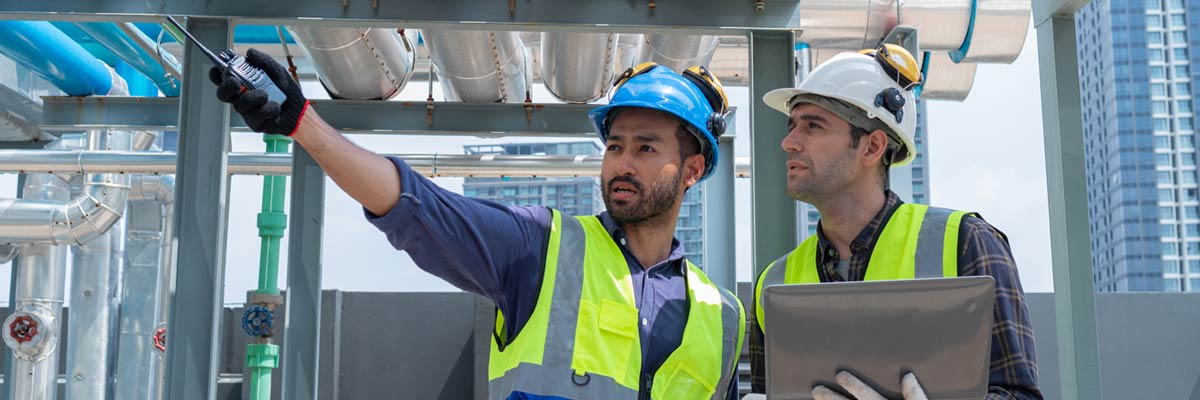Indoor Air Quality (IAQ) Standards and Compliance in Australia
Ensuring compliance with Indoor Air Quality (IAQ) standards is essential for occupant health, HVAC system efficiency, and legal adherence in Australian buildings. Poor IAQ can lead to respiratory issues, reduced productivity, and non-compliance with regulatory requirements. This article outlines key IAQ standards and compliance based on National Construction Code (NCC) 2022, AS/NZS 1668.2 Ventilation Standards, World Health Organization (WHO) IAQ guidelines, Safe Work Australia, Australian Institute of Refrigeration, Air Conditioning and Heating (AIRAH), Green Building Council of Australia IAQ guidelines, ASHRAE & ISO standards.
1. Minimum Ventilation Requirements
Proper ventilation ensures indoor air quality meets acceptable standards and maintains a healthy indoor environment.
NCC 2022 Reference:
Section F6P3 (Volume One) & H4P5(1) (Volume Two) requires occupied spaces to be provided with outdoor air ventilation sufficient to maintain adequate air quality. They references AS/NZS 1668.2, which prescribes airflow rates for different building types.
AS/NZS 1668.2 Ventilation Standards:
- Offices: Minimum 10 L/s per person (litres per second)
- Classrooms: 8 L/s per person
- Healthcare facilities: 15 L/s per person
- Retail spaces: 10 L/s per person
- Residential dwellings: 0.35 air changes per hour (ACH)
2. Filtration Standards for IAQ Compliance
NCC 2022 Reference:
Section F6P4 requires mechanical ventilation systems to control odours and accumulation of harmful contaminants (e.g., microorganisms, toxins).
AS/NZS 1668.2 IAQ Requirements:
- MERV 8 (ASHRAE 52.2) or ISO ePM10 50% minimum for commercial buildings.
- MERV 13 / ePM1 80% recommended for healthcare and high-density spaces.
3. Natural Ventilation Provisions
Utilizing natural ventilation can be an effective strategy for maintaining IAQ, depending on building design and environmental conditions.
NCC 2022 Reference:
- F6D7 (Volume One) – Natural ventilation must be achieved through openings such as windows, doors, or other devices with a ventilating area of at least 5% of the floor area of the room being ventilated. These openings must be open to a suitably sized court, space open to the sky, an open verandah, carport, or an adjoining room compliant with F6D8.
- F6D8 (Volume One) – Natural ventilation can also be borrowed from adjoining rooms, provided both rooms are within the same sole-occupancy unit or common property. Specific ventilation area requirements apply depending on the building class.
- F6P3 (Volume One) – Requires that any space occupied by people must have ventilation providing outdoor air to maintain adequate indoor air quality
IAQ Standards:
- AS/NZS 1668.2 – Recommends the use of natural ventilation where feasible to reduce dependence on mechanical ventilation and ensure sufficient fresh air exchange.
- WHO – Encourages maximizing outdoor air supply to mitigate indoor air pollutants such as carbon dioxide (CO₂), particulate matter (PM), and volatile organic compounds (VOCs).
4. Energy Recovery and IAQ Optimisation
Integrating energy reclaiming technologies such as Energy Recovery Ventilators (ERVs), maintain IAQ while minimising energy loss.
NCC 2022 Reference:
- J5 (Volume One) – Energy Efficiency Requirements for HVAC systems, mandating IAQ improvements without excessive energy use.
- J6D4 (Volume One, Section 1.b) – Requires that a mechanical ventilation system, including one that is part of an air-conditioning system (except those serving single-occupancy units in Class 2 building or serves only Class 4 part of a building) must — when serving a conditioned space (except in periods when evaporative cooling is being used) — where specified in Table J6D4 — have an energy reclaiming system (or ERVs) that preconditions outdoor air at a minimum sensible heat transfer effectiveness of 60% or implement demand control ventilation per AS 1668.2, where applicable.
The table below specifies the required Outdoor Air Treatment depending on the airflow and climate zone.
Table J6D4 Required Outdoor Air Treatment
| Climate Zone | Outdoor Airflow (L/s) | Required Measure |
| 1 | >500 | Modulating control |
| 2 | Not applicable | No required measure |
| 3 | >1000 | Modulating control |
| 4 and 6 | >500 | Modulating control or energy reclaiming system |
| 5 | >1000 | Modulating control or energy reclaiming system |
| 7 and 8 | >250 | Modulating control or energy reclaiming system |
IAQ Standards:
- ASHRAE Standards 62.1 & 62.2, and Standard 90.1 – Highlight the significance of adequate ventilation for acceptable IAQ and recognize the role of energy recovery systems in achieving this efficiently. Specifically, they recognize that incorporating energy recovery systems can enhance ventilation effectiveness while optimizing energy use.
- ISO ICS 91.140.30 – Pertains to ventilation and air-conditioning systems, acknowledging technologies like ERVs that enhance energy efficiency while maintaining IAQ.
- ISO Standards: ISO 16494-1:2022 specifies methods for testing the performance of heat recovery ventilators (HRVs) and ERVs, highlighting their role in enhancing energy efficiency in ventilation systems.
Practical Consideration:
Implement hybrid ventilation (natural + mechanical) to optimise energy use.
5. Carbon Dioxide (CO₂) and Air Contaminant Limits for Indoor Air Quality
IAQ compliance is verified through contaminant level limits, ensuring a safe indoor environment.
NCC 2022 Reference:
Table F6V1 (Volume One) & Table H4V3 (Volume Two) list acceptable maximum contaminant limits. Some of them are outlined below. The complete list can be accessed here.
| Pollutant | Maximum Limit | Averaging Time |
| CO₂ | 850 ppm | 8 hours |
| CO | 90 ppm | 15 minutes |
| Formaldehyde (CH₂O) | 0.1 mg/m³ | 30 minutes |
| NO₂ | 40 µg/m³ (0.0197 ppm) | 1 year |
| PM2.5 | 10 µg/m³ | 1 year |
| PM10 | 50 µg/m³ | 24-hour (99th percentile) |
IAQ Standards:
- AS/NZS 1668.2 recommends CO₂ levels below 850 ppm for occupied spaces.
- WHO IAQ Guidelines suggest <1000 ppm CO₂ level for general indoor spaces.
- Safe Work Australia Guidelines propose CO₂ levels of <5000 ppm (8-hour TWA)
Australian Institute of Refrigeration, Air Conditioning and Heating (AIRAH) IAQ Guidelines:
Install sensors to track CO2 levels, PM2.5, and particulate matter. Use automated control systems to adjust ventilation rates based on real-time air quality data.
6. Control of Volatile Organic Compounds (VOCs)
NCC 2022 Reference:
Section F6P4 & F6P5 implies the use of low-emission materials to minimize indoor pollutants.
IAQ Standards:
- WHO limits total VOCs (TVOCs) to <0.3 mg/m³ for long-term exposure.
- AS/NZS 1668.2 recommends source control through low-VOC materials and enhanced ventilation.
- Safe Work Australia suggests total volatile organic compounds (TVOCs) of <500 µg/m³
- Green Building Council of Australia (GBCA) – Green Star IAQ Criteria specifies to use low-VOC materials for paints, adhesives, and furniture
7. Airborne Pathogen Mitigation
Enhanced IAQ measures reduce airborne disease transmission in high-occupancy buildings.
NCC 2022 Reference:
Section F6 emphasizes mechanical ventilation strategies to mitigate airborne contaminants.
IAQ Standards:
- AS/NZS 1668.2 recommends HEPA filtration (≥99.97% efficiency) for critical environments.
- WHO advises increasing fresh air rates above standard requirements in pandemic scenarios.
- AIRAH IAQ Guidelines suggests deployment of Ultraviolet Germicidal Irradiation (UVGI), commonly known as UV-C disinfection, in HVAC systems, particularly in critical areas such as operating rooms and the like. According to AIRAH, “UVGI devices installed in air systems can effectively neutralize microorganisms, including pathogens, viruses, and molds present in these environments”.
8. Monitoring and IAQ Compliance
Ensuring ongoing compliance with IAQ standards requires periodic assessment and monitoring.
NCC 2022 Reference:
Verification Methods are outlined in F6V1 and H4V3, which provide criteria for assessing whether ventilation systems achieve acceptable IAQ. These methods involve measuring indoor contaminant levels and comparing them to specified limits to verify compliance.
AS/NZS 1668.2 sets out requirements for regular maintenance of ventilation systems. This implies having regular IAQ assessment to maintain mandated indoor air quality.
Best Practices for Compliance:
- Conduct quarterly IAQ testing (CO₂, PM2.5, VOCs).
- Implement real-time IAQ sensors for automated compliance tracking.
Adherence to IAQ standards, as outlined in NCC 2022 and AS/NZS 1668.2:2024, is fundamental for creating healthy indoor environments. By understanding and implementing the specified ventilation requirements, building professionals can ensure compliance and promote occupant well-being.
References:
- National Construction Code (NCC) 2022 – ncc.abcb.gov.au
- AS/NZS 1668.2: The Use of Ventilation and Air Conditioning in Buildings – standards.org.au
- World Health Organization (WHO) IAQ Guidelines – https://www.who.int/publications
- Safe Work Australia IAQ Guidelines– safeworkaustralia.gov.au
- Green Building Council of Australia – new.gbca.org.au
- AIRAH IAQ Guideline – https://airah.org.au/
- ASHRAE – https://www.ashrae.org/technical-resources/
- ISO Standard – https://www.iso.org/ics/
This document is provided by Caeli, an HVAC solutions provider, to outline IAQ standards and compliance. Always refer to manufacturer guidelines and local building regulations for specific installation and compliance requirements.

